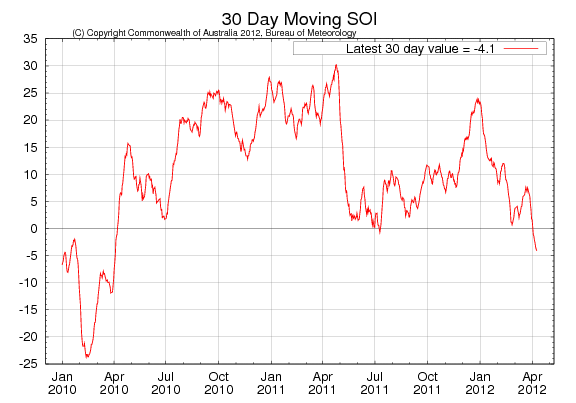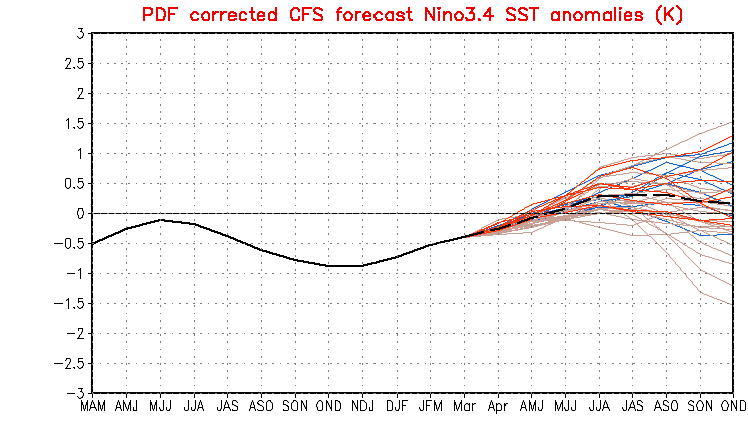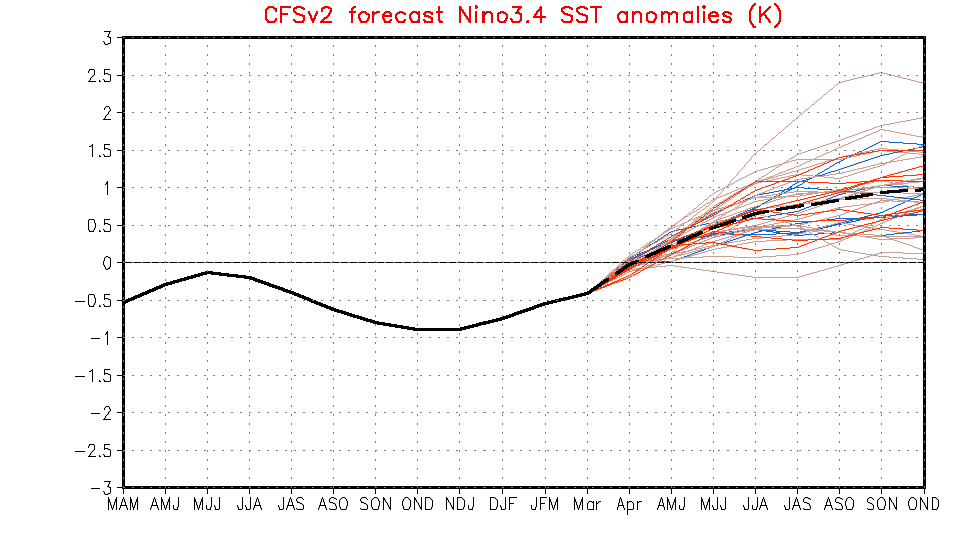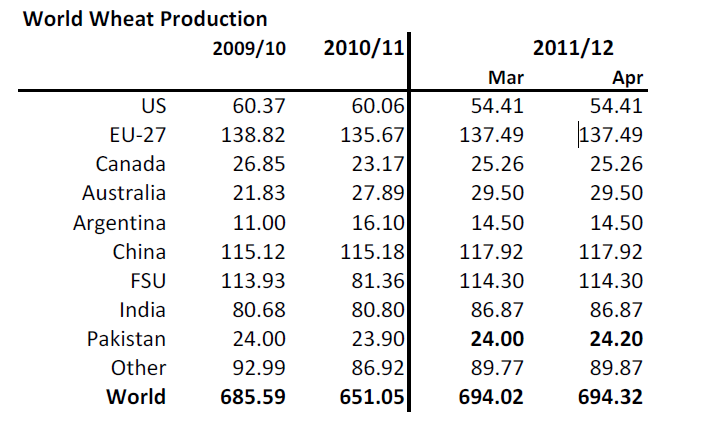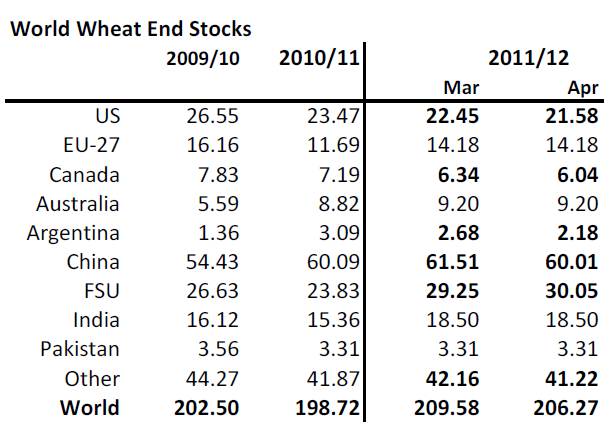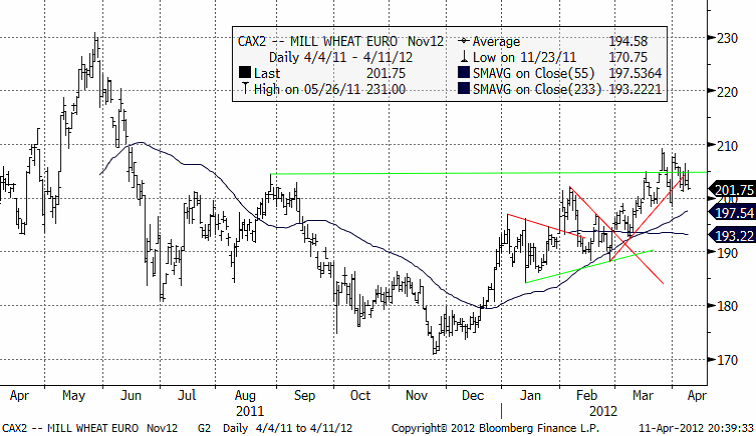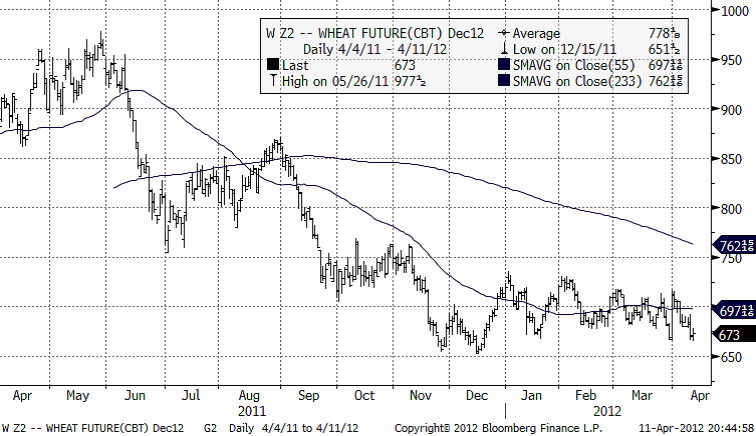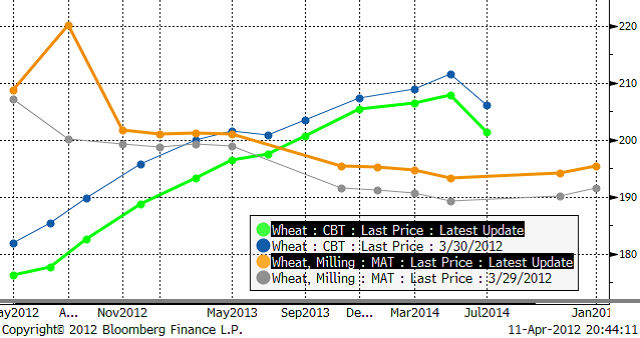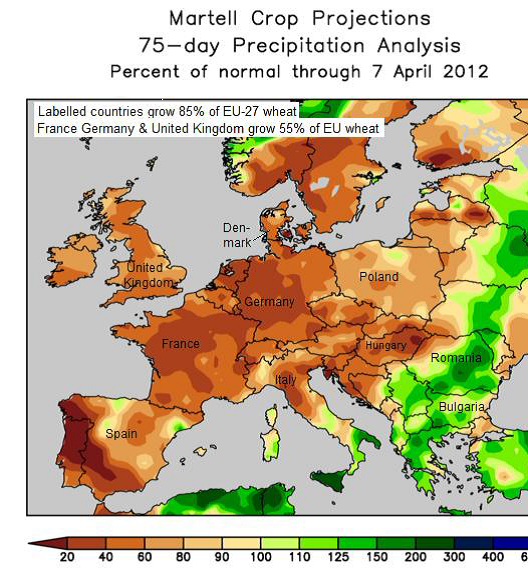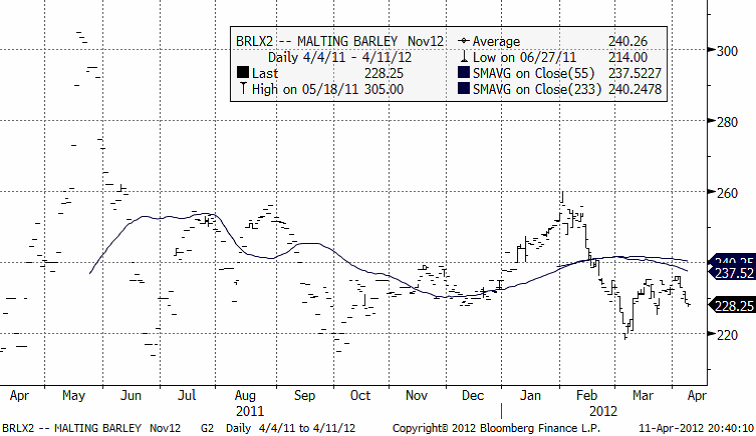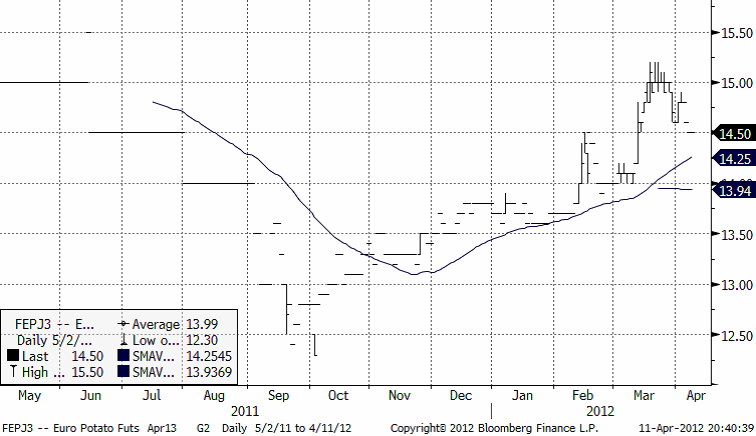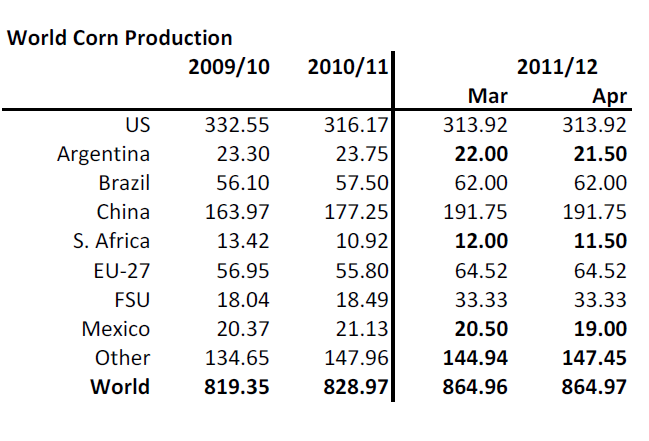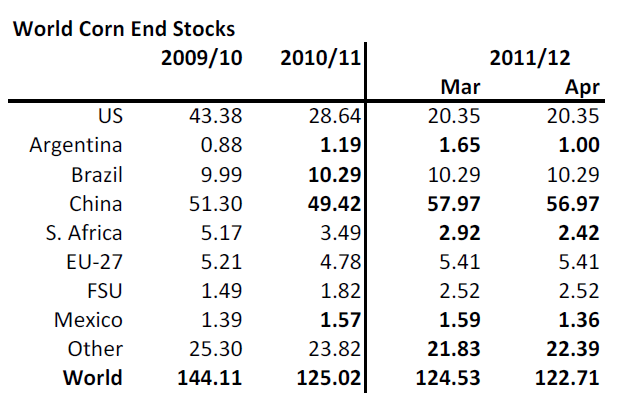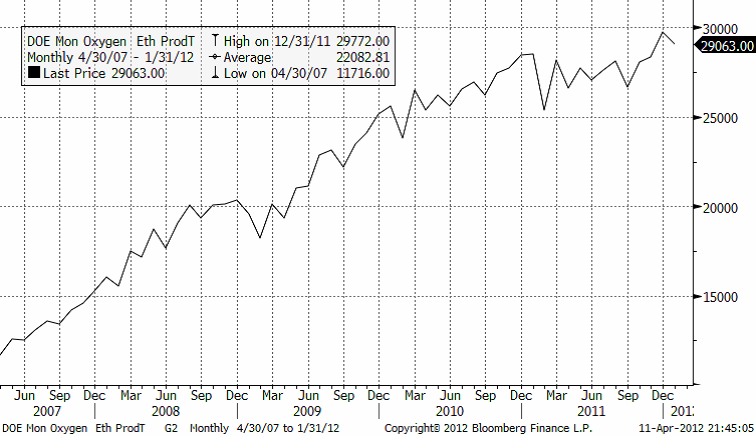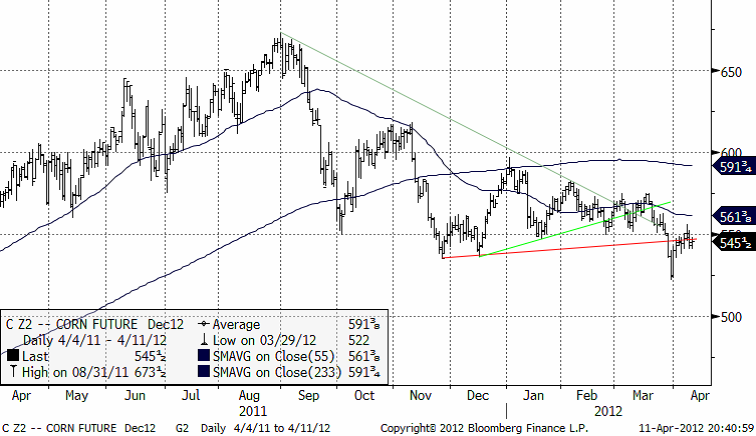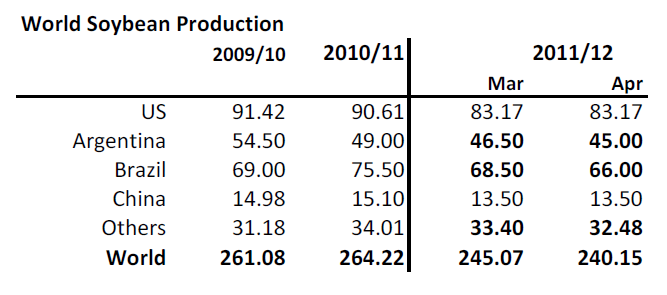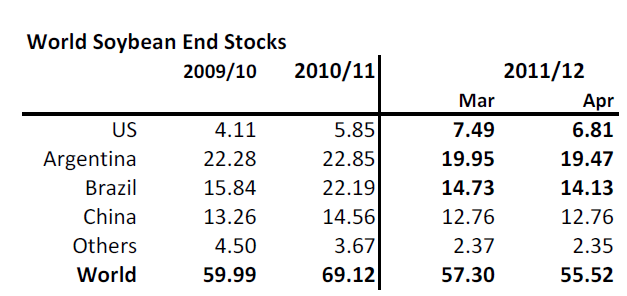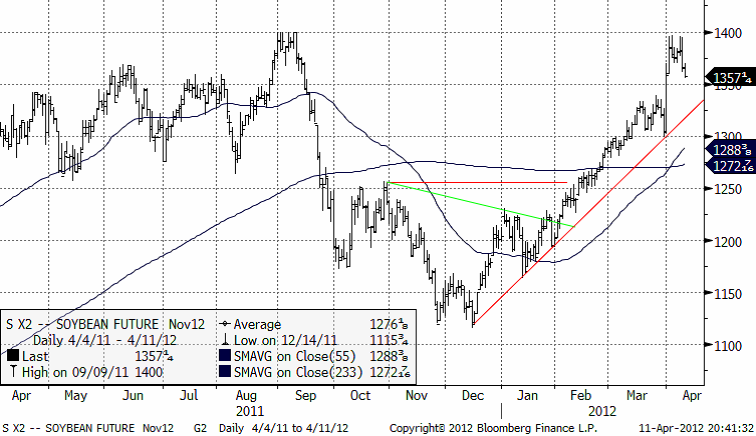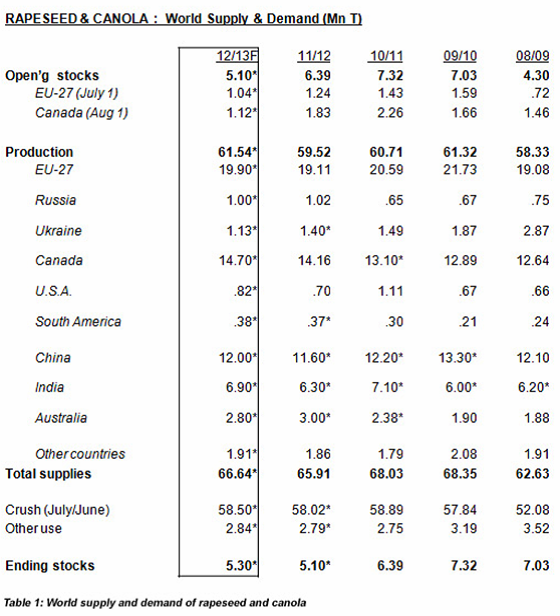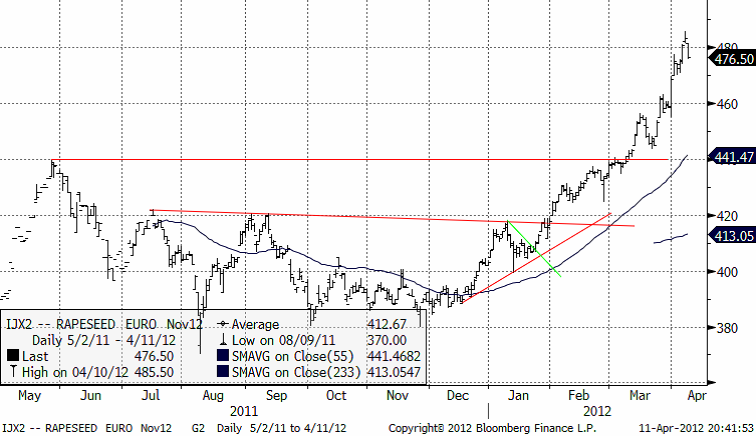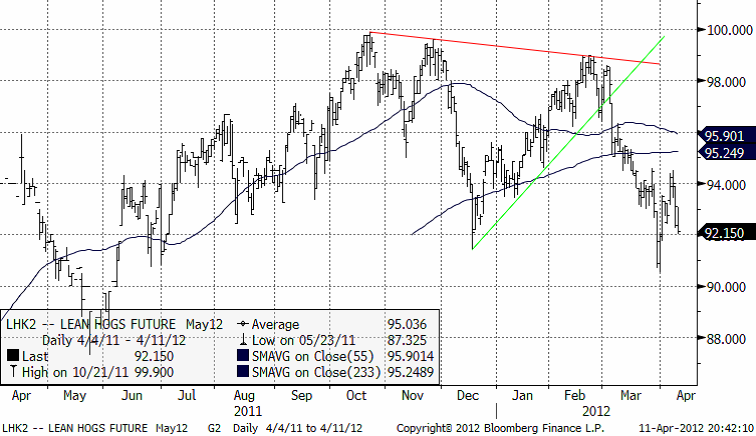Analys
SEB – Jordbruksprodukter, vecka 15 2012
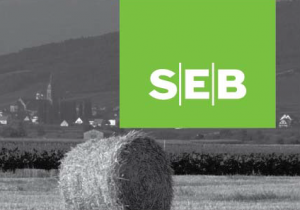 Vetepriset i USA har fallit med 5% sedan förra veckan. Bakom ligger flera faktorer, bland annat bättre väder. I omvärlden noterar vi en ny uppgång i räntorna i Spanien, en ny våg av misstro som vi inte sett sedan november förra året. Vi noterar att arbetsmarknaden i USA utvecklas svagt, enligt fredagens statistik.
Vetepriset i USA har fallit med 5% sedan förra veckan. Bakom ligger flera faktorer, bland annat bättre väder. I omvärlden noterar vi en ny uppgång i räntorna i Spanien, en ny våg av misstro som vi inte sett sedan november förra året. Vi noterar att arbetsmarknaden i USA utvecklas svagt, enligt fredagens statistik.
Sentimentet på aktiemarknaderna runt om i världen är rejält svagt. Kina, den stora motorn bakom råvaruboomen tycks hacka. Man kan tänka sig att sämre ekonomi i världen dämpar efterfrågan på mat. Den korrelationen är dock svag. Det viktigaste just nu tycker vi är utvecklingen av ENSO, som vi börjar brevet med.
Odlingsväder
Nedan ser vi Southern Oscillation Index, som mäter ENSO och indikerar La Niña om SOI > +8 och El Niño om SOI < -8. Vi ser att SOI minskat från +0.3 förra veckan till -4.1 i dagens rapport. Det är den lägsta nivån sedan mars för två år sedan. Prognoserna om ett möjligt El Niño och därmed vanligtvis följande superskörd ser ut att besanna
NOAA:s två senaste ensembleprognoser publicerades den 9 april den första är något högre, dvs något mer El Niño, medan den andra modellens prognoser ligger något lägre än de vi hade med i förra veckans veckobrev.
Nedan ser vi den andra modellen, CFS.v2, som också förutspår neutrala ENSO-förhållanden, men är kraftigare på El Niño-sidan för hösten.
Vete
Egypten, världens största importör av vete, har återigen köpt 115 000 ton av amerikanskt ursprung med leverans 21-31 maj enligt GASC.
[ Vinnande bud; USA; 55kt för 259.75$/t + frakt 24.00$/t från Alex Grain + 60kt för 259.75$/t + frakt 26.00$/t från Venus ]
WASDE-rapporten som publicerades av USDA i fredags visade inte på någon förändring alls vad gäller produktionsestimaten, som vi ser nedan.
Konsumtionen har justerats upp med 3 mt på global basis. Utgående lager sänks mest i Kina och i USA. Även Kanadas utgående lager sänks.
Det är väldigt små förändringar överlag. Rapporten ger ingen ny information att handla efter. Prisförändringarna blev också mycket små. Nedan ser vi novemberkontraktet på Matif. 210-nivån är ännu inte bruten, noterar vi.
Vi måste bara titta på Chicagokontraktet med ungefär samma löptid som Matifs novemberkontrakt. Decembervetet på CBOT har haft en helt annan prisutveckling de senaste månaderna än Matifkontraktet. När det har varit en prisuppgång på Matif har det varit ”sidledes” rörelse, till och med med en liten nedgång i USA.
Vän av ordning kanske då tänker på eurons svaga utveckling mot dollarn, men detta är inte hela förklaringen. I diagrammet nedan ser vi hur terminskurvorna för Chicagovete och Matifvete förändrat sig de senaste 7 handelsdagarna. Vi ser att Chicago fortsatt att falla, generellt. Matif har stigit, generellt. Som vanligt ser vi att augusti-kontraktet, detta illikvida kontrakt som snart ska försvinna, beter sig konstigt.
Utsikterna för den totala veteskörden i Europa ter sig dåliga just nu. Martell skriver den 9 april om torka, utvintring och dålig utveckling i östra Europa. Strategie Grains sänkte, som vi tidigare nämnt, estimaten för veteskörden i EU-27 förra månaden till 139.5 mt, vilket trots detta är 1.5% högre än förra året. Nedan ser vi nederbörden i förhållande till normalt för de senaste 75 dagarna i Europa.
Men vi måste komma ihåg att det troligtvis ser som sämst ut just nu. Med La Niña borta och kanske ett El Niño på väg att bildas kan vädret bli mycket bättre. Skörden i Europa har påverkats väldigt lite av vädret under januari till mars och mycket mer av vädret under maj, juni och juli. Utsikterna för detta ser mycket bättre ut.
Maltkorn
Novemberkontraktet på maltkorn ligger fortfarande under glidande medelvärden och det brukar tolkas negativt.
Potatis
Priset på industripotatis för leverans nästa år tog en paus efter förrförra veckans kraftiga prisuppgång. Priset har 15 euro som fixpunkt för den aktuella handeln.
Majs
Brasiliens produktion av majs för 2011/12 förväntas slå nytt rekord och Conab justerar upp sin prognos till 65.1 mt från 61.7 mt. Landet, som är världens tredje största producent av majs efter USA och Kina, producerade 57.4 mt majs under föregående skördeår.
Brasiliens skörd av majs (sommargröda) är nu till stor del avklarad och verkar bli något lägre till följd av det torra vädret, som också drabbat sojabönor. Däremot förväntas det gynnsamma vädret i centrala och västra delar av landet, som t.ex Mato Grosso, ge lantbrukare chansen att få ut det mesta möjliga av sin rekordstora sådd av majs som vintergröda (safrinha).
USDA verkar inte ha hängt med i svängarna här. De gjorde ingen justering av väntad produktion i Brasilien utan ligger kvar på 62 mt, 3mt under Conab. Vi tror mer på Conab. Allt annat lika borde det kunna innebära att global skörd, i USDA:s termer, är större, än vad man trodde förra månaden.
Konsumtionen i Kina justeras upp 1 mt av USDA. Bakom det ligger ett justerande av ingående lager, konsumtion och utgående lager, men i princip är innebörden att konsumtionen väntas öka med 1 mt.
USDA justerar ner etanolproduktionen i USA. Kritik mot detta har riktats mot USDA. Kritiken har menat att etanolproduktionen inte alls minskat i USA, men tillgänglig statistik stödjer USDA:s beslut.
Nedan ser vi etanolproduktionen per månad i 1000 fat i USA, enligt Department of Energys rapport. Den stora tillväxten i produktionen ligger bakom oss och hittills i år ser vi en nedgång i produktionen.
Prisreaktionen i decemberkontraktet på CBOT var en prisnedgång, som vi ser i nedanstående kursdiagram.
Vi går igång, trots allt, på den tekniska bilden. Rekylen upp mot 550 cent ser riktigt ”bearish” ut. Lite bättre väder i USA, lite lägre siffror i Southern Oscillation Index, och priset kan få en ordentlig skjuts nedåt.
Sojabönor
Brasilianska Conab publicerade en ny prognos för skördeåret 2011/12 igår. Skördeåret startade den 1 september och merparten redan har skördats. Conab justerade ner skördeprognosen till 65.6 mt från den tidigare uppskattningen på 68.7 mt som publicerades för en månad sedan och från 75.3 mt under föregående skördeår. Detta trots en ökning av areal med 3,4% till rekordhöga 25 miljoner hektar.
Odlare av sojabönor i Brasilien, världens näst största producent efter USA, kommer enligt Conab att skörda mindre än vad tidigare prognoser har visat efter att det torra vädret som associeras med La Nina har skadat grödor i landets södra delar, framförallt i regionerna Rio Grande do Sul och Parana där de största bortfallen väntas med 44 respektive 36 procent.
Torka har plågat flera av de södra sojabönsproducerande regionerna i Brasilien, Argentina och Paraguay, som tillsammans står för mer än hälften av världens handel med sojabönor. WASDE-rapporten från USDA justerade också ner skörden, med 2.5 mt och landar på ungefär samma siffra som Conab, 66 mt. Skörden i Argentina justeras också ner och tillsammans är de den största anledningen till att global produktion sänks med 5 mt i denna april månads rapport.
Konsumtionen i Sydamerika sänks med 2 mt vilket bidrar till att globala utgående lager bara sänks med drygt 2 mt.
Det var en klart ”bullish” rapport, men marknaden har valt att ta fasta på den negativa statistiken för global ekonomi (efterfrågesidan) som kom samtidigt och fick aktiemarknaderna att falla runtom i världen. Nederbörd i USA tycks också ge vatten på kvarnen för dem som pekat på att ett El Niño kan vara i antågande.
Tekniskt noterar vi att prisuppgången vände precis på 1400 cent, som lockade fram säljarna även vid toppen i september förra året.
Raps
Även om kanadensiska lantbrukare uppnår en rekordskörd av canola på 14.5-15 mt i slutet av sommaren 2012, är det stor sannolikhet att den globala produktionen av raps och canola inte kommer att kunna möte efterfrågan under 2012/13 – framförallt pga av dåliga utsikter för höstgrödorna i EU och Ukraina.
Oil World uppskattar en ökning av arealen för kanadensisk canola med 3-4% till en ny högsta nivå på 7.9 miljoner hektar (jämfört med 7.6 miljoner hektar i fjol). Canola har haft en fenomenal utveckling i Kanada och arealen har i stort sett fördubblats under en 10-årsperiod från 3.9 miljoner hektar under våren 2002. Som en följd av detta har dock produktionen av spannmål, framförallt korn och vete, minskat kraftigt.
Enligt preliminära prognoser kommer den globala produktionen av raps och canola att uppgå till 61.5 mt, vilket motsvarar en måttlig återhämtning på 2 mt från nuvarande säsong. Detta under förutsättningen gynnsamma väderförhållanden och ökad sådd i Kanada och Indien.
Nedan ser vi kursdiagrammet för novemberkontraktet, som gick upp över 480 euro per ton innan priset föll tillbaka och stängde på 476.5 euro igår, onsdag.
440 euro utgör nu, när den nivån är bruten, ett tekniskt stöd. Vi fortsätter därför att ha en neutral vy, om inte 440-nivån bryts igen.
Gris
Majkontraktet som steg till över 94 cent har nu fallit ner mot 92 cent, en stödnivå igen. Svagare ekonomisk statistik väcker oro för efterfrågan.
[box]SEB Veckobrev Jordbruksprodukter är producerat av SEB Merchant Banking och publiceras i samarbete och med tillstånd på Råvarumarknaden.se[/box]
Disclaimer
The information in this document has been compiled by SEB Merchant Banking, a division within Skandinaviska Enskilda Banken AB (publ) (“SEB”).
Opinions contained in this report represent the bank’s present opinion only and are subject to change without notice. All information contained in this report has been compiled in good faith from sources believed to be reliable. However, no representation or warranty, expressed or implied, is made with respect to the completeness or accuracy of its contents and the information is not to be relied upon as authoritative. Anyone considering taking actions based upon the content of this document is urged to base his or her investment decisions upon such investigations as he or she deems necessary. This document is being provided as information only, and no specific actions are being solicited as a result of it; to the extent permitted by law, no liability whatsoever is accepted for any direct or consequential loss arising from use of this document or its contents.
About SEB
SEB is a public company incorporated in Stockholm, Sweden, with limited liability. It is a participant at major Nordic and other European Regulated Markets and Multilateral Trading Facilities (as well as some non-European equivalent markets) for trading in financial instruments, such as markets operated by NASDAQ OMX, NYSE Euronext, London Stock Exchange, Deutsche Börse, Swiss Exchanges, Turquoise and Chi-X. SEB is authorized and regulated by Finansinspektionen in Sweden; it is authorized and subject to limited regulation by the Financial Services Authority for the conduct of designated investment business in the UK, and is subject to the provisions of relevant regulators in all other jurisdictions where SEB conducts operations. SEB Merchant Banking. All rights reserved.
Analys
Sell the rally. Trump has become predictable in his unpredictability

Hesitant today. Brent jumped to an intraday high of $66.36/b yesterday after having touched an intraday low of $60.07/b on Monday as Indian and Chinese buyers cancelled some Russian oil purchases and instead redirected their purchases towards the Middle East due to the news US sanctions. Brent is falling back 0.4% this morning to $65.8/b.

It’s our strong view that the only sensible thing is to sell this rally. In all Trump’s unpredictability he has become increasingly predictable. Again and again he has rumbled about how he is going to be tough on Putin. Punish Putin if he won’t agree to peace in Ukraine. Recent rumbling was about the Tomahawk rockets which Trump threatened on 10 October and 12 October to sell/send to Ukraine. Then on 17 October he said that ”the U.S. didn’t want to give away weapons (Tomahawks) it needs”.
All of Trump’s threats towards Putin have been hot air. So far Trump’s threats have been all hot air and threats which later have evaporated after ”great talks with Putin”. After all these repetitions it is very hard to believe that this time will be any different. The new sanctions won’t take effect before 21. November. Trump has already said that: ”he was hoping that these new sanctions would be very short-lived in any case”. Come 21. November these new sanctions will either evaporate like all the other threats Trump has thrown at Putin before fading them. Or the sanctions will be postponed by another 4 weeks or 8 weeks with the appearance that Trump is even more angry with Putin. But so far Trump has done nothing that hurt Putin/Russia. We can’t imagine that this will be different. The only way forward in our view for a propre lasting peace in Ukraine is to turn Ukraine into defensive porcupine equipped with a stinging tail if need be.
China will likely stand up to Trump if new sanctions really materialize on 21 Nov. Just one country has really stood up to Trump in his tariff trade war this year: China. China has come of age and strength. I will no longer be bullied. Trump upped tariffs. China responded in kind. Trump cut China off from high-end computer chips. China put on the breaks on rare earth metals. China won’t be bullied any more and it has the power to stand up. Some Chinese state-owned companies like Sinopec have cancelled some of their Russian purchases. But China’s Foreign Ministry spokesperson Guo Jiakun has stated that China “oppose unilateral sanctions which lack a basis in international law and authorization of the UN Security Council”. Thus no one, not even the US shall unilaterally dictate China from whom they can buy oil or not. This is yet another opportunity for China to show its new strength and stand up to Trump in a show of force. Exactly how China choses to play this remains to be seen. But China won’t be bullied by over something as important as its oil purchases. So best guess here is that China will defy Trump on this. But probably China won’t need to make a bid deal over this. Firstly because these new sanctions will either evaporate as all the other threats or be postponed once we get to 21 November. Secondly because the sanctions are explicit towards US persons and companies but only ”may” be enforced versus non-US entities.
Sanctions is not a reduction in global supply of oil. Just some added layer of friction. Anyhow, the new sanctions won’t reduce the supply of Russian crude oil to the market. It will only increase the friction in the market with yet more need for the shadow fleet and ship to ship transfer of Russian oil to dodge the sanctions. If they materialize at all.
The jump in crude oil prices is probably due to redirections of crude purchases to the Mid-East and not because all speculators are now turned bullish. Has oil rallied because all speculators now suddenly have turned bullish? We don’t think so. Brent crude has probably jumped because some Indian and Chinese oil purchasers of have redirected their purchases from Russia towards the Mid-East just in case the sanctions really materializes on 21 November.
Analys
Brent crude set to dip its feet into the high $50ies/b this week

Parts of the Brent crude curve dipping into the high $50ies/b. Brent crude fell 2.3% over the week to Friday. It closed the week at $61.29/b, a slight gain on the day, but also traded to a low of $60.14/b that same day and just barely avoided trading into the $50ies/b. This morning it is risk-on in equities which seems to help industrial metals a little higher. But no such luck for oil. It is down 0.8% at $60.8/b. This week looks set for Brent crude to dip its feet in the $50ies/b. The Brent 3mth contract actually traded into the high $50ies/b on Friday.

The front-end backwardation has been on a weakening foot and is now about to fully disappear. The lowest point of the crude oil curve has also moved steadily lower and lower and its discount to the 5yr contract is now $6.8/b. A solid contango. The Brent 3mth contract did actually dip into the $50ies/b intraday on Friday when it traded to a low point of $59.93/b.
More weakness to come as lots of oil at sea comes to ports. Mid-East OPEC countries have boosted exports along with lower post summer consumption and higher production. The result is highly visibly in oil at sea which increased by 17 mb to 1,311 mb over the week to Sunday. Up 185 mb since mid-August. On its way to discharge at a port somewhere over the coming month or two.
Don’t forget that the oil market path ahead is all down to OPEC+. Remember that what is playing out in the oil market now is all by design by OPEC+. The group has decided that the unwind of the voluntary cuts is what it wants to do. In a combination of meeting demand from consumers as well as taking back market share. But we need to remember that how this plays out going forward is all at the mercy of what OPEC+ decides to do. It will halt the unwinding at some point. It will revert to cuts instead of unwind at some point.
A few months with Brent at $55/b and 40-50 US shale oil rigs kicked out may be what is needed. We think OPEC+ needs to see the exit of another 40-50 drilling rigs in the US shale oil patches to set US shale oil production on a path to of a 1 mb/d year on year decline Dec-25 to Dec-26. We are not there yet. But a 2-3 months period with Brent crude averaging $55/b would probably do it.
Oil on water increased 17 mb over the week to Sunday while oil in transit increased by 23 mb. So less oil was standing still. More was moving.

Crude oil floating storage (stationary more than 7 days). Down 11 mb over week to Sunday

The lowest point of the Brent crude oil curve versus the 5yr contract. Weakest so far this year.

Crude oil 1mth to 3mth time-spreads. Dubai held out strongly through summer, but then that center of strength fell apart in late September and has been leading weakness in crude curves lower since then.

Analys
Crude oil soon coming to a port near you

Rebounding along with most markets. But concerns over solidity of Gaza peace may also contribute. Brent crude fell 0.8% yesterday to $61.91/b and its lowest close since May this year. This morning it is bouncing up 0.9% to $62.5/b along with a softer USD amid positive sentiment with both equities and industrial metals moving higher. Concerns that the peace in Gaza may be less solid than what one might hope for also yields some support to Brent. Bets on tech stocks are rebounding, defying fears of trade war. Money moving back into markets. Gold continues upwards its strong trend and a softer dollar helps it higher today as well.

US crude & products probably rose 5.6 mb last week (API) versus a normal seasonal decline of 2.4 mb. The US API last night partial and thus indicative data for US oil inventories. Their data indicates that US crude stocks rose 7.4 mb last week, gasoline stocks rose 3.0 mb while Distillate stocks fell 4.8 mb. Altogether an increase in commercial crude and product stocks of 5.6 mb. Commercial US crude and product stocks normally decline by 2.4 mb this time of year. So seasonally adjusted the US inventories rose 8 mb last week according to the indicative numbers by the API. That is a lot. Also, the counter seasonal trend of rising stocks versus normally declining stocks this time of year looks on a solid pace of continuation. If the API is correct then total US crude and product stocks would stand 41 mb higher than one year ago and 6 mb higher than the 2015-19 average. And if we combine this with our knowledge of a sharp increase in production and exports by OPEC(+) and a large increase in oil at sea, then the current trend in US oil inventories looks set to continue. So higher stocks and lower crude oil prices until OPEC(+) switch to cuts. Actual US oil inventory data today at 18:00 CET.
US commercial crude and product stocks rising to 1293 mb in week 41 if last nights indicative numbers from API are correct.

Crude oil soon coming to a port near you. OPEC has lifted production sharply higher this autumn. At the same time demand for oil in the Middle-East has fallen as we have moved out of summer heat and crude oil burn for power for air-conditioning. The Middle-East oil producers have thus been able to lift exports higher on both accounts. Crude oil and condensates on water has shot up by 177 mb since mid-August. This oil is now on its way to ports around the world. And when they arrive, it will likely help to lift stocks onshore higher. That is probably when we will lose the last bit of front-end backwardation the the crude oil curves. That will help to drive the front-month Brent crude oil price down to the $60/b line and revisit the high $50ies/b. Then the eyes will be all back on OPEC+ when they meet in early November and then again in early December.
Crude oil and condensates at sea have moved straight up by 177 mb since mid-August as OPEC(+) has produced more, consumed less and exported more.

-

 Nyheter4 veckor sedan
Nyheter4 veckor sedanOPEC+ missar produktionsmål, stöder oljepriserna
-

 Nyheter2 veckor sedan
Nyheter2 veckor sedanGoldman Sachs höjer prognosen för guld, tror priset når 4900 USD
-

 Nyheter3 veckor sedan
Nyheter3 veckor sedanBlykalla och amerikanska Oklo inleder ett samarbete
-

 Nyheter3 veckor sedan
Nyheter3 veckor sedanGuld nära 4000 USD och silver 50 USD, därför kan de fortsätta stiga
-

 Nyheter2 veckor sedan
Nyheter2 veckor sedanLeading Edge Materials är på rätt plats i rätt tid
-

 Nyheter2 veckor sedan
Nyheter2 veckor sedanNytt prisrekord, guld stiger över 4000 USD
-

 Nyheter3 veckor sedan
Nyheter3 veckor sedanEtt samtal om guld, olja, koppar och stål
-

 Analys3 veckor sedan
Analys3 veckor sedanOPEC+ will likely unwind 500 kb/d of voluntary quotas in October. But a full unwind of 1.5 mb/d in one go could be in the cards


